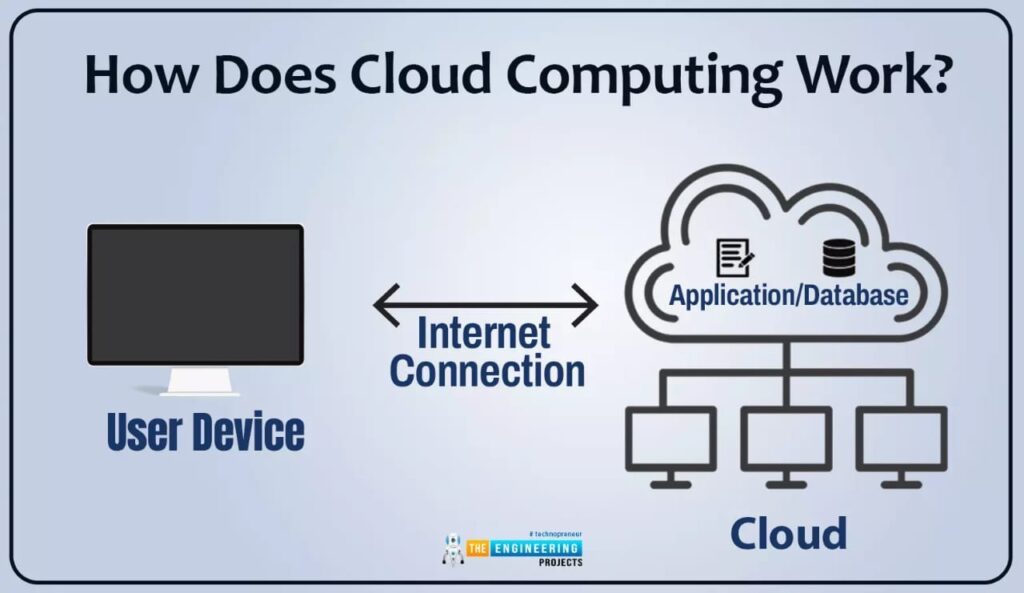How Cloud Computing Works
“Ever wondered where your data goes when you upload it to the cloud? Let’s take a simple tour of how cloud computing works behind the scenes!”
If you’re new to this concept, check out our detailed beginner’s guide to cloud computing basics and benefits.
Introduction: Demystifying the Cloud Engine
In today’s digital world, cloud computing powers everything from your photo backups to streaming your favorite shows. But do you truly understand how cloud computing works behind the scenes?
This guide breaks down each layer of the cloud ecosystem — in simple language — using real-world analogies and examples. Whether you’re a student, tech enthusiast, or startup founder, this post will give you a crystal-clear picture of how cloud computing works.
The 4 Pillars of How Cloud Computing Works
Let’s break down the key building blocks that make the cloud possible.
1. 🏢 Global Data Centers – The Brains Behind the Cloud
At the heart of cloud computing are data centers — large, secured buildings filled with thousands of servers (powerful computers). These are strategically placed around the world to ensure global coverage and speed.
🌍 Real-World Analogy:
Think of data centers as warehouses. Instead of storing products, they store your data and applications. When you request something (like opening a Google Doc), the system checks which warehouse is closest to you, grabs the document, and delivers it.
💡 Did You Know?
“According to Amazon Web Services, cloud computing is…”
Google, AWS, and Microsoft each maintain over 100 data centers globally — a major reason how cloud computing works so fast regardless of your location.
2. ⚙️ Virtualization – Multiplying the Power of Hardware
Data centers run on physical hardware, but each server can be split into multiple virtual machines (VMs) using a technique called virtualization.
🧠 Deep Dive:
A physical server may be capable of handling 10+ different tasks. Instead of dedicating one server per user, virtualization allows cloud providers to divide resources logically.
Each VM operates as a separate machine with its own CPU, memory, and operating system — yet all run from the same physical hardware.
🌐 Analogy:
Imagine a hotel with one big room. Virtualization turns it into many smaller, independent rooms (VMs) where different users can stay privately — that’s how cloud computing works efficiently and cost-effectively.
3. 🌐 Internet Connectivity – The Highway to the Cloud
The Internet is the delivery system of the cloud. Every time you upload a file, open an app, or stream a video, your device sends and receives data through internet protocols to/from cloud servers.
🔍 Real Breakdown:
When you upload a photo, your data is split into packets and securely transferred to the nearest cloud server.
The entire process (upload, encrypt, store, replicate) happens in milliseconds — thanks to optimized routing algorithms.
🛡️ Bonus: Security
Cloud data transfers use encryption (like SSL/TLS) to protect your files. So when you wonder how cloud computing works securely — this is a key part.
4. ⚖️ Resource Allocation and Load Balancing – Keeping It Fast and Stable
Cloud platforms handle millions of users simultaneously. To manage this, they use software-based systems to distribute resources dynamically — this is called autoscaling and load balancing.
📊 Real Scenario:
If 1000 users start using an app at once, the system detects the spike and auto-allocates more servers to maintain performance.
It also balances the traffic between servers so no single machine gets overloaded.
This real-time adaptability is one of the most critical answers to how cloud computing works reliably under pressure.
Microsoft Azure describes cloud computing as a transformative model that enables businesses to scale faster, reduce costs, and access advanced services on demand. You can explore their detailed explanation here.

How Cloud Computing Works – Step-by-Step Walkthrough
Let’s take a closer look at what happens when you upload a file to the cloud (e.g., Google Drive).
✅ 1. Upload Initiation
You select a photo and tap “Upload.” Your device prepares the file for transmission.
✅ 2. Internet Transfer
The file is split into data packets and sent to the nearest cloud data center through encrypted channels.
✅ 3. Load Balancing
Cloud routing decides the best VM and data center to handle the request.
✅ 4. Virtualization in Action
The selected VM processes the file, may apply compression/encryption, and stores it securely.
✅ 5. Distributed Storage
The file is saved not just once, but copied across multiple regions to ensure backup and accessibility.
✅ 6. Retrieval
When you access the file again, it’s served from the closest data center for maximum speed.
🧩 This end-to-end process explains how cloud computing works in the real world with reliability and speed.
Want to explore how cloud computing compares to other models like edge or quantum computing? Dive into our post on the 8 types of computing you must know.
🎬 More Examples to Clarify the Concept
Netflix Streaming
Netflix relies on cloud networks to deliver movies quickly. As you start playback, servers closest to your location stream the data. This illustrates how cloud computing works to deliver low-latency, high-quality video.
Google Docs Collaboration
When multiple users edit a document simultaneously, updates sync in real time across cloud servers. This collaboration capability demonstrates how cloud computing works for seamless, globally accessible editing.
Instagram Photo Upload
Every image is processed, resized, and stored on cloud servers immediately. Later, when users scroll, cloud infrastructure instantly retrieves and displays those photos. That’s how cloud computing works under everyday use.



How Does Cloud Computing Deliver Services? (Technical Breakdown)
Cloud computing delivers services using a combination of virtualization, APIs, automation, and orchestration. At its core, it abstracts physical hardware and delivers computing power via the internet.
Virtualization allows multiple operating systems and applications to run on the same physical server, improving efficiency.
APIs (Application Programming Interfaces) enable users and developers to interact with cloud platforms programmatically.
Automation ensures that processes like provisioning resources or scaling infrastructure can be done with minimal human intervention.
Orchestration ties these automated processes together to create efficient workflows — such as auto-scaling web servers based on traffic demand.
Together, these layers enable seamless delivery of computing resources like storage, databases, and networks in a scalable, secure, and cost-effective way.
Who Uses Cloud Computing? (Use Cases by Sector)
Cloud computing isn’t just for IT professionals. Here’s how various industries are leveraging the cloud:
| Industry | Cloud Use Case Example |
|---|---|
| Education | Online learning platforms (e.g., Google Classroom) |
| Healthcare | Secure patient data storage & remote diagnosis |
| Finance | Fraud detection and secure online transactions |
| Retail | Scalable eCommerce sites with AI personalization |
| Entertainment | Streaming platforms like Netflix use cloud for global distribution |
This flexibility is what makes cloud computing a foundational technology in today’s digital economy.
🔹 3. 🌍 Advantages of Cloud Computing in Developing Countries
Cloud computing is especially powerful in developing regions where access to large-scale infrastructure is limited.
Enables startups to build apps without buying expensive servers
Gives students access to online labs and learning tools
Supports remote work and digital entrepreneurship
Reduces digital divide by democratizing access to tech
With only a laptop and an internet connection, users can launch services that were once restricted to big companies.
🔹 4. 📈 Cloud Adoption Trends and Growth Stats
According to Gartner, global cloud spending is projected to exceed $679 billion by 2024. Businesses are shifting away from on-premises systems to cloud-native architectures.
Top growth areas include:
Edge computing integration with cloud
Multi-cloud strategies to avoid vendor lock-in
Rise of serverless architectures (like AWS Lambda)
This upward trend proves that understanding how cloud computing works isn’t just a tech skill — it’s a business necessity.
🔹 5. 🔐 Is Cloud Computing Safe? (Security Explained Simply)
Security is one of the biggest concerns when it comes to cloud adoption — and rightly so. But top providers invest heavily in protecting your data.
Here’s how cloud platforms ensure safety:
Encryption: Data is encrypted at rest and in transit
Redundancy: Data is stored in multiple locations (regions/availability zones)
Access Control: You can manage user permissions and roles
Monitoring & Audits: Continuous tracking of threats and suspicious activities
Still, it’s important for users to practice shared responsibility — cloud providers secure the infrastructure, but you must secure your own applications and data access policies.
How Cloud Handles Requests in Real-Time
Explain step-by-step how a simple request is processed, like opening Google Drive or uploading a file.
Let’s say you’re uploading a file to a cloud service like Dropbox. Here’s how cloud computing works behind the scenes:
Your device (client) sends a request via the internet.
The request is routed through secure protocols (like HTTPS) to the cloud provider.
Load balancers direct your request to an available server.
The file is stored on cloud storage, often split and distributed across multiple servers.
A response is sent back to your device confirming success.
This simplified workflow explains how cloud computing works for millions of users daily.
Demonstrate how cloud computing works in different industries.
The way cloud computing works can differ slightly based on the use case:
In education, students access virtual classrooms hosted in the cloud via web browsers.
In e-commerce, product data is pulled from cloud databases in real time when users browse.
In healthcare, cloud computing securely processes patient data and makes it accessible across departments.
These real-world examples show that how cloud computing works is both scalable and adaptable.
How Security Works in Cloud Computing
A major part of how cloud computing works involves securing the entire data flow. Providers use encryption (both at rest and in transit), identity access management (IAM), firewalls, and monitoring tools to detect and block threats.
Security in cloud computing is designed to protect users without slowing down performance—making it a vital part of how cloud computing works at scale.
Conclusion: What You’ve Learned
To wrap up, understanding how cloud computing works helps you better appreciate the systems powering our digital lives. Whether you’re streaming a video, backing up your photos, or deploying an app, it’s cloud infrastructure doing the heavy lifting behind the scenes. From virtualization and data routing to storage and security, every step is a part of how cloud computing delivers fast, reliable, and scalable services.You now understand how cloud computing works — from physical data centers and virtualization to smart routing and real-life usage. This knowledge gives you the foundation to dive deeper into cloud platforms like AWS, Google Cloud, and Microsoft Azure.
🚀 Stay tuned for our next post:
“Top Cloud Providers in 2025: AWS vs Azure vs GCP for Beginners”